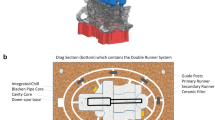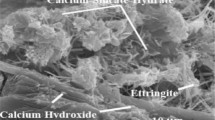Abstract
Pre-cast concrete products are sometimes manufactured in two cycles per day production with one mold for the purpose of productivity improvement. In such cases, to secure the early strength, which is required at demolding, it is necessary to increase the steam-curing temperature. However, when this is done, the issue of temperature-related cracking becomes a concern. In addition, self-compacting concrete to which ground-granulated blast-furnace slag has been added is increasingly being used in consideration of the environment surrounding a plant and the operating environment. Admixing with an expansive agent prevents cracking due to autogenous shrinkage. However, when an expansive agent is admixed with concrete, the possibility also exists that the high-temperature curing required for two cycles per day production may increase the likelihood of cracking. In this study, the cause of cracking of large-sized pre-cast concrete products with high amounts of expansive agent was investigated and the products of one cycle per day production compared to those of two cycles per day production. The results obtained indicate that, in contrast to one cycle per day production, high-temperature steam curing and early demolding in two cycles per day production promote thermal stress cracking. In addition, unexpected cracking can occur along the main reinforcement resulting from excessive expansion due to inappropriate curing of the expansive agent.












Similar content being viewed by others
References
Shi N, Ouyang J, Zhang R, Huang D (2014) Experimental study on early-age crack of mass concrete under the controlled temperature history. Adv Mater Sci Eng 2014:1–10
Nam HP, Hosoda A (2014) Mechanism for improving crack resistance of slag concrete with high alite cement. J Jpn Soc Civ Eng 2:239–248
Da Silva L, Wilson R, Petro S, De Lucena S, Diogo S, Prudencio LR (2011) Surface appearance of precast elements fabricated using self-consolidating concrete. Concr Int 33(10):39–44
Okamura H, Maekawa K, Ozawa K (1993) High performance concrete. Gihodo Shuppan Co., Ltd., Japan
Okamura H, Ouchi K, Ozawa K (2003) Self-compacting concrete. J Adv Concr Technol 1(1):5–15
Bier T, Rizwan S (2014) Ecological, economical and environmental aspects of self-compacting concrete—present and future. Int J Soc Mater Eng Resour 20(1):12–16
Japan Society of Civil Engineers (2007) Concrete Technology Series 74: Evaluation of Performance and Characteristics Transition of Concrete with Mixture Materials, Research Small Committee (333 Committee) Report, Appendix document, pp I-270–I-271
Suami K, Otomo K, Hara T, Yamagami M (2003) Investigation of cracking phenomenon due to autogenous shrinkage in slab with bottom restrained. Annu Proc Concr Eng 25(2):685–690
Kanda T, Momose H, Imamoto K (2015) Shrinkage cracking resistance of blast furnace slag blended cement concrete—influencing factors and enhancing measures. J Adv Concr Technol 13(1):1–14
Son Ha Ngoc, Hosoda Akira (2010) Detection of microcracking in concrete subjected to elevated temperature at very early age by acoustic emission. J Adv Concr Technol 8(2):201–211
Kanda T, Momose H, Imamoto K, Ishizeki K (2015) Quantitative evaluation of crack resistance mechanism of blast furnace slag cement concrete via restrained shrinkage stress analysis. J Adv Concr Technol 1:421–437
Date S, Hasegawa S, Kobayashi K, Sakuma T (2007) Study of quality improvement on secondary products mixed with blast-furnace slag. Japan Society of Civil Engineers 62nd Annual Academic Conference, pp 477–478
Tazawa E, Miyazawa S (1992) Autogenous shrinkage caused by self desiccation in cementitious material. In: Proceedings of the 9th International Congress on the Chemistry of Cement, pp IV712–IV718
Mitani H, Tanimura M, Sakuma T, Satake S (2003) Effect of curing temperature on characteristics of restrained expansion of concrete mixed with expansive agent. Annu Proc Concr Eng 25(1):155–160
Kobayashi S, Ozawa M, Morimoto H (2010) Temperature dependence of expansion energy using expansion mortar. Annu Proc Concr Eng 32(1):125–129
Ramezanianpour AA, Khazali MH, Vosoughi P (2013) Effect of steam curing cycles on strength and durability of SCC: a case study in precast concrete. Constr Build Mater 49:807–813
Sakuma T, Satake S, Mitani H, Tanimura M, Turuta M (2003) Effect of curing temperature on strength characteristics of expansive concrete. Japan Society of Civil Engineers 58th Annual Academic Conference, pp 337–338
Kodama A, Hosoda A, Son Ha Ngoc, Ono A (2003) Contraction of concrete mixed with ground granulated blast-furnace slag of low water-powder ratio which experienced high temperature process. Annu Proc Concr Eng 30(1):363–368
Tsuji Y (1981) Estimation method of distribution of chemical pre-stress and expansion. Annu Proc Concr Eng 19(6):99–105
Ito H, Maruyama I, Tanimura M, Sato R (2004) Early age deformation and resultant induced stress in expansive high strength concrete. J Adv Concr Technol 2(2):155–174
Tanimura M, Maruyama I, Sato R (2009) Autogenous deformation and resultant induced stress in low-shrinkage high-strength concrete. In: Proceedings of the 8th International Conference on Creep, Shrinkage and Durability of Concrete and Concrete Structures, pp 855–862
Author information
Authors and Affiliations
Corresponding author
Rights and permissions
About this article
Cite this article
Maruyama, T., Karasawa, H., Hashimoto, S. et al. Effect of Expansive Agent and Temperature on the Quality of Pre-cast Concrete Products. Int J Civ Eng 15, 263–271 (2017). https://doi.org/10.1007/s40999-016-0080-8
Received:
Revised:
Accepted:
Published:
Issue Date:
DOI: https://doi.org/10.1007/s40999-016-0080-8




